Childhood Osteoporosis Risk Assessment Tool
Assessment Guide
Use this tool to evaluate potential risk factors for childhood osteoporosis. Answer the following questions honestly to get personalized recommendations.
Your Child's Risk Profile
Recommended Actions
Imagine a teenager who breaks a wrist from a minor fall or a growing child who constantly complains of bone pain. It’s not just bad luck - those could be signs of childhood osteoporosis, a condition that steals bone strength when kids should be building it.
Understanding why it happens and how to stop it is the first step toward stronger, healthier kids. Below you’ll find a plain‑spoken guide that walks you through the main causes, the warning signs, and doable prevention tactics you can start using today.
What is Childhood Osteoporosis?
Childhood osteoporosis is a disorder where a child's bones become less dense and more fragile than normal for their age. Unlike adult osteoporosis, which usually shows up after decades of bone loss, this form can appear even before the teen years, often linked to genetic, medical, or lifestyle factors that interrupt the natural bone‑building process. Kids with this condition may experience frequent fractures, chronic bone pain, or a noticeable loss of height as their spine compresses.
Major Causes and Risk Factors
There isn’t a single culprit. Most cases arise from a mix of genetics, health conditions, medication side effects, and nutrition or activity gaps.
- Genetic disorders such as osteogenesis imperfecta, hypophosphatasia, or rare collagen‑type mutations permanently affect bone quality.
- Chronic illnesses like juvenile rheumatoid arthritis, cystic fibrosis, inflammatory bowel disease, and type1 diabetes can interfere with the body’s ability to lay down new bone.
- Long‑term medication use - especially glucocorticoids (steroids), anticonvulsants, and certain chemotherapy agents - reduces calcium absorption and boosts bone resorption.
- Nutritional deficiencies of calcium, vitaminD, magnesium, and protein starve bones of the building blocks they need.
- Physical inactivity limits the mechanical stress that tells bones to grow stronger.
Other contributors include very low body weight, eating disorders, and excess caffeine or sugary drinks that leach calcium.
How to Spot the Problem Early
Kids rarely complain about bone health until something breaks. Keep an eye out for these red flags:
- Repeated fractures from low‑impact injuries (e.g., falling off a bike).
- Persistent bone or joint pain without clear injury.
- Loss of height or a noticeable “stooped” posture.
- Delayed growth or failure to gain expected weight.
If any of these appear, a pediatrician will likely order a Dual‑energy X‑ray absorptiometry (DXA) scan. This painless test measures bone mineral density (BMD) in the spine, hip, or whole body and provides a numeric score (Z‑score) comparing the child’s bone density to healthy peers.
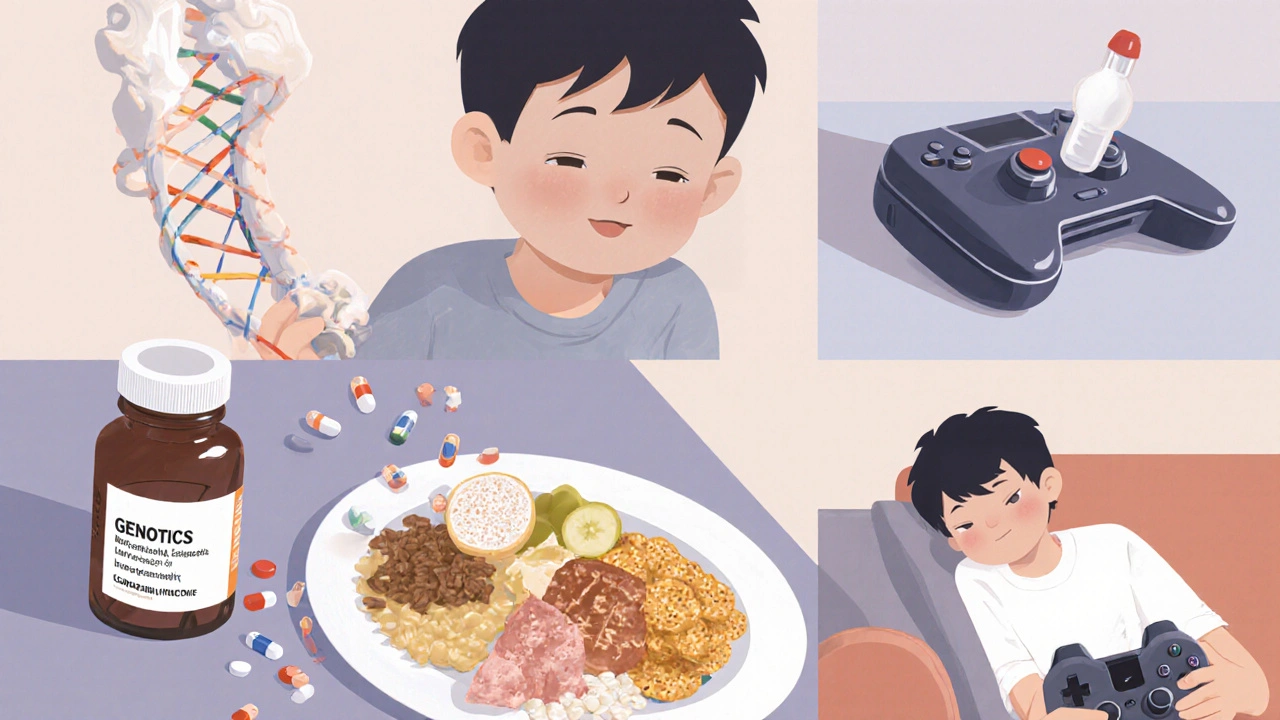
Evidence‑Based Prevention Strategies
Preventing bone loss is far easier than trying to rebuild lost bone. The key is to supply the right nutrients, encourage weight‑bearing activity, and manage any underlying health issues.
1. Optimize Calcium Intake
Calcium is the main mineral in bone. The National Institutes of Health recommends 1,300mg per day for teens aged 9‑18 and 1,000mg for younger children. Good sources include:
- Milk, yogurt, and cheese (plain versions are best).
- Fortified plant milks (almond, soy) that list calcium+vitaminD.
- Leafy greens such as kale and bokchoy (though spinach contains oxalates that reduce absorption).
- Calcium‑set tofu and canned fish with soft bones (sardines, salmon).
2. Ensure Adequate VitaminD
VitaminD helps the gut absorb calcium. Sunlight remains the cheapest source - 10‑15minutes of midday sun a few times a week usually suffices for lighter‑skinned kids, a bit longer for those with darker skin. Dietary sources and supplements fill gaps:
- Fatty fish (salmon, mackerel), egg yolks.
- VitaminD‑fortified milk, orange juice, cereals.
- Supplements: 600-1,000IU daily for children, per pediatric guidelines, especially in winter months.
3. Prioritize Weight‑Bearing Physical Activity
Activities that push against gravity stimulate bone formation. Aim for at least 60minutes of moderate‑to‑vigorous exercise most days:
- Running, jumping rope, soccer, basketball.
- Gymnastics, dance, or martial arts - anything that involves hops and landings.
- Resistance training with body weight (push‑ups, squats) or light free weights (under supervision).
Even short “bone‑boost” bursts-10seconds of jumping followed by 20seconds rest-can be effective when done repeatedly.
4. Maintain a Healthy Body Weight
Both underweight and severe obesity strain bone health. Undernutrition deprives bones of nutrients, while excess fat can trigger inflammatory hormones that increase bone loss. Balanced meals with adequate protein (15‑20% of calories) support bone‑matrix formation.
5. Review Medications with Your Doctor
If your child takes steroids for asthma or inflammatory disease, talk to the pediatrician about the lowest effective dose, intermittent “drug holidays,” or adding bone‑protective agents like bisphosphonates (used rarely in children under specialist care).
6. Regular Check‑ups and Monitoring
For kids with known risk factors (genetic disease, chronic illness), schedule annual BMD testing and labs for calcium, vitaminD, and alkaline phosphatase. Early intervention can keep bone loss from progressing.
Putting It All Together: A Sample Bone‑Healthy Week
Here’s a practical snapshot you can adapt for a 12‑year‑old:
- Monday: Breakfast - fortified cereal + milk; after school, 30minutes of basketball.
- Tuesday: Snack - yogurt with almonds; after dinner, 15‑minute walk in the park (sunny).
- Wednesday: Lunch - kale salad with grilled chicken; after school, resistance circuit (push‑ups, squats, lunges) - 3sets each.
- Thursday: Snack - cheese stick + apple; evening family bike ride - 45minutes.
- Friday: Breakfast - scrambled eggs + spinach; after school, soccer practice 60minutes.
- Weekend: Weekend brunch includes fortified orange juice; 1‑hour hike on Saturday (sun exposure, weight‑bearing); Sunday rest with light stretching.
Adjust portions to meet daily calcium targets, and keep a vitaminD supplement handy during cloudy weeks.
Common Myths Debunked
- Myth: Only adults get osteoporosis.
Fact: Children can develop it too, especially if they have risk factors. - Myth: Drinking milk will automatically protect bones.
Fact: Milk is useful, but you still need vitaminD, weight‑bearing activity, and overall balanced nutrition. - Myth: High‑impact sports are dangerous for weak bones.
Fact: Controlled, progressive impact actually strengthens bones; the key is proper technique and gradual load increase.
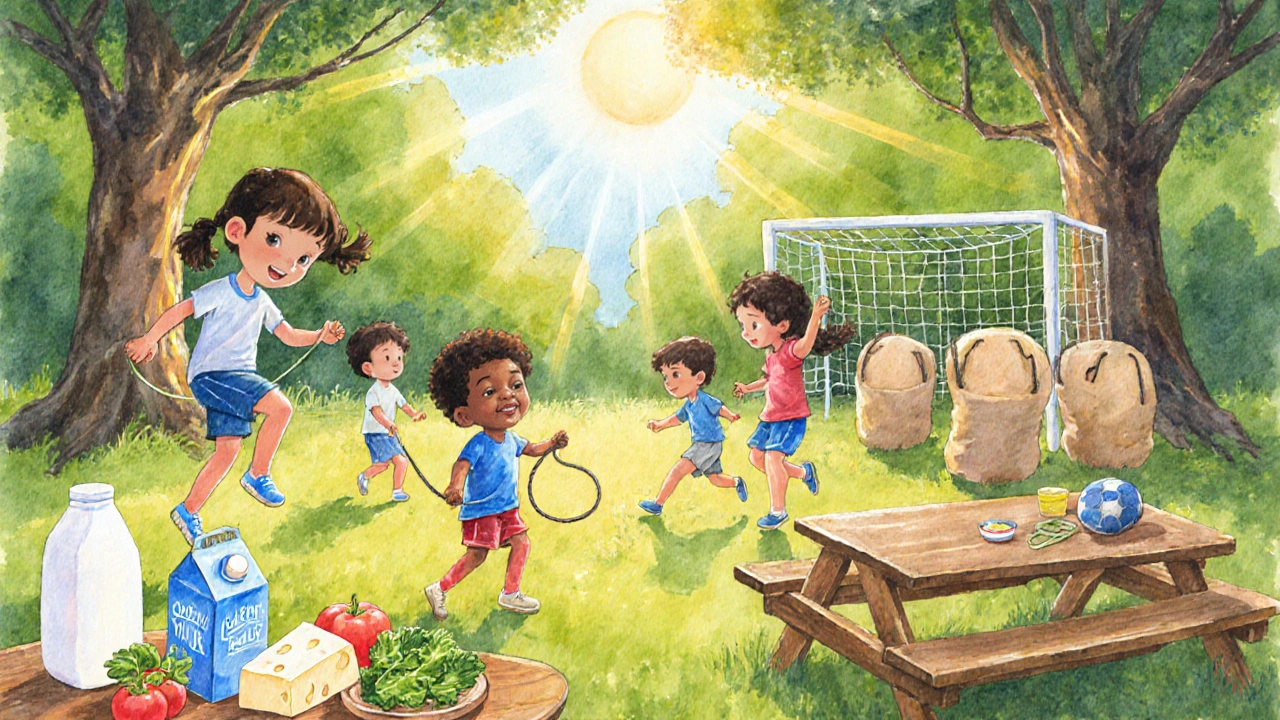
When to Seek Professional Help
If you notice any of the warning signs listed earlier, book an appointment with a pediatrician promptly. Ask for a referral to a pediatric endocrinologist or a bone‑health specialist if the doctor suspects a systemic cause. Early diagnosis means more options for treatment and a better chance of catching up on bone density during growth spurts.
Key Takeaways
- Childhood osteoporosis can stem from genetics, chronic disease, meds, poor nutrition, and inactivity.
- Screening with a DXA scan gives a clear picture of bone density.
- Boost calcium (1,300mg/day) and vitaminD (600‑1,000IU/day), and encourage daily weight‑bearing exercise.
- Regular medical monitoring is essential for at‑risk kids.
- Small, consistent lifestyle tweaks can dramatically improve bone health before adulthood.
| Risk Factor | Preventive Action |
|---|---|
| Genetic bone disorders | Early specialist referral; calcium/vitaminD supplementation; tailored exercise program |
| Long‑term steroid use | Lowest effective dose; periodic bone density scans; consider bone‑protective meds under specialist guidance |
| Calcium‑poor diet | Include dairy or fortified alternatives; add leafy greens and calcium‑rich snacks daily |
| VitaminD deficiency | Safe sun exposure; vitaminD‑fortified foods; daily supplement during winter |
| Physical inactivity | At least 60minutes of weight‑bearing activity most days; incorporate short jump‑bursts |
| Low body weight | Balanced diet with adequate protein; monitor growth curves; involve a nutritionist if needed |
Frequently Asked Questions
At what age can children develop osteoporosis?
While rare in early childhood, osteoporosis can appear as early as age5 in kids with strong genetic conditions or chronic illnesses. Most cases are identified in pre‑teens and early teens when growth spikes demand more calcium and vitaminD.
Is a DXA scan safe for kids?
Yes. A DXA uses low‑dose X‑rays (less than a standard chest X‑ray) and is considered the gold standard for measuring bone mineral density in children. The scan takes only a few minutes and involves no radiation risk when performed by a qualified technician.
Can dairy‑free diets increase osteoporosis risk?
They can, if calcium isn’t replaced with fortified plant milks or other calcium‑rich foods. Vegan or lactose‑intolerant families should aim for at least 1,300mg of calcium daily from sources like fortified soy milk, calcium‑set tofu, almonds, and leafy greens.
How much vitaminD is enough during winter?
Most pediatric guidelines recommend 600-1,000IU daily for children aged 1‑18 during low‑sun months. Blood tests can confirm if levels are adequate; a level above 30ng/mL is generally considered sufficient.
Are weight‑bearing exercises safe for kids with low bone density?
Yes, when supervised and progressed gradually. Start with low‑impact activities (walking, light jumping) and increase intensity as tolerance improves. A physiotherapist can design a safe program tailored to the child’s BMD score.
Can medications like bisphosphonates be used in children?
In severe cases, pediatric endocrinologists may prescribe bisphosphonates to slow bone loss and stimulate new bone formation. Treatment is closely monitored, and the decision is based on DXA results, fracture history, and underlying condition.


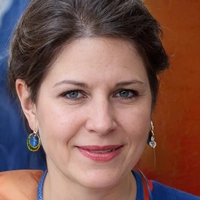


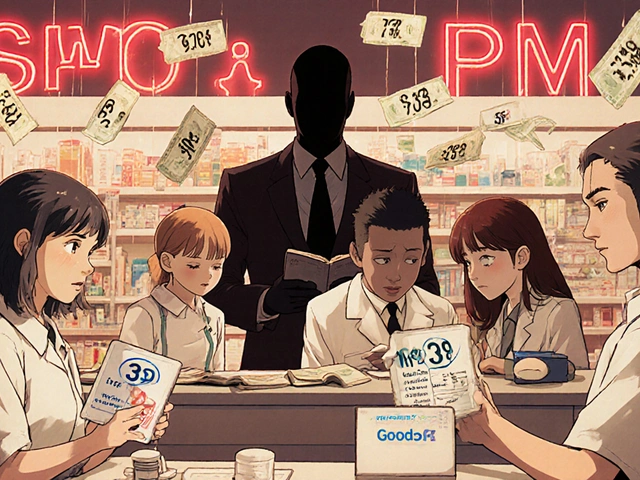

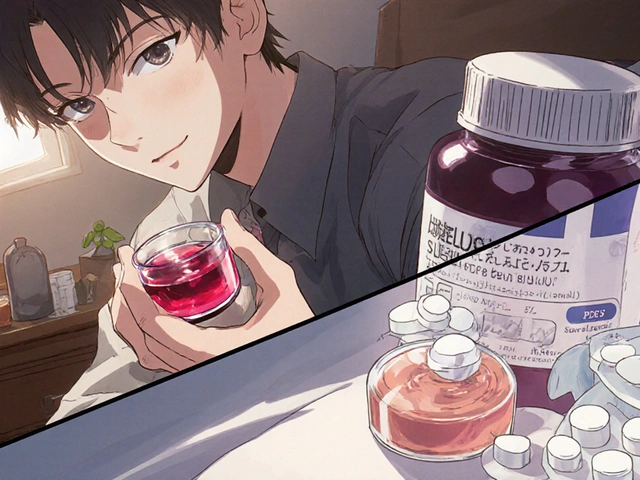
Sharon Bruce October 7, 2025
🇺🇸 We’ve got plenty of dairy at home, so make sure kids hit that 1,300 mg calcium goal every day – milk, cheese, or fortified alternatives keep those bones strong. 💪
True Bryant October 7, 2025
Honestly, the pathophysiology of pediatric osteoporosis can’t be reduced to “just get more milk.” It’s a multifactorial syndrome involving osteoblastic suppression, glucocorticoid‑induced apoptosis, and dysregulated RANKL/OPG signaling. If you ignore the endocrine axis, you’re basically prescribing a placebo. 👀
Danielle Greco October 7, 2025
Great point! Adding calcium‑rich foods is just the tip of the iceberg-think leafy greens, fortified plant milks, and calcium‑set tofu. 🍽️ Consistency matters more than a single serving, so sprinkle those goodies throughout the day for optimal absorption.
Linda van der Weide October 7, 2025
One could argue that focusing solely on biochemical cascades misses the larger existential narrative: a child’s body is a dialogue between genetics and environment, and neglecting either side leads to a silent erosion of potential. The ethical imperative, therefore, is to harmonize therapy with lifestyle, not to worship a singular mechanistic model.
Philippa Berry Smith October 8, 2025
It’s suspicious how quickly the “simple diet fix” narrative spreads, as if big dairy conglomerates are funding the research. While calcium is essential, the emphasis on dairy neglects the role of phosphorous overload from processed foods that silently sabotage bone mineralization.
Joel Ouedraogo October 8, 2025
Regardless of hidden agendas, the empirical evidence remains clear: adequate vitamin D synthesis-whether via solar exposure or supplementation-acts as the catalyst for calcium deposition. The philosophical lesson is simple: empower the body with the fundamentals before entertaining speculative motives.
Beth Lyon October 8, 2025
yeah i think the part about weight‑bearing exercise is key, kids should be runnin around, jump rope or even just play tag. it’s easy and helps the bones get stronger.
Nondumiso Sotsaka October 8, 2025
Exactly! Incorporating short “bone‑boost” bursts-like 10 seconds of jumping rope followed by a quick rest-can be woven into playground time. 🌟 Consistency beats intensity, so encourage daily fun activities rather than occasional marathon sessions.
Ashley Allen October 8, 2025
Balanced nutrition and regular activity are the cornerstone.
Brufsky Oxford October 8, 2025
When we contemplate the fragility of childhood bones, we are reminded that the skeletal system is not merely a static scaffold but a dynamic organ responsive to mechanical and hormonal cues. 🦴 The first decade of life is a critical window where osteoblastic activity outpaces resorption, setting the foundation for lifelong skeletal health. Yet this equilibrium can be disturbed by chronic inflammation, glucocorticoid therapy, or inadequate micronutrients, leading to a cascade of micro‑fractures that often go unnoticed. Nutrition, therefore, is not a peripheral concern but a central pillar; calcium provides the raw material, while vitamin D functions as the keys that unlock intestinal absorption. Moreover, magnesium and vitamin K2 play synergistic roles in hydroxyapatite crystal formation, a fact too often omitted from lay summaries. Physical activity injects mechanical strain into bone matrix, stimulating the Wnt signaling pathway and promoting bone formation. Weight‑bearing exercises such as jumping, sprinting, and resistance training are especially potent because they create high‑impact forces that the skeleton perceives as a call to fortify itself. Even brief, high‑intensity bursts- ten seconds of squat jumps followed by rest-can trigger osteogenic responses when repeated throughout the day. Sleep, often undervalued, facilitates growth hormone release, which in turn supports osteoblast differentiation. Psychosocial stress, conversely, elevates cortisol, which may accelerate bone resorption, highlighting the need for a holistic approach. Regular monitoring with DXA scans offers a quantitative snapshot, allowing clinicians to adjust interventions before irreversible loss occurs. In cases where pharmacologic support is warranted, bisphosphonates have demonstrated efficacy in increasing bone density, though they must be administered under specialist supervision. Ultimately, the most sustainable strategy intertwines diet, sunlight, movement, and vigilant medical oversight, crafting a resilient framework that carries the child into adulthood. 🌞💪 Parents can model healthy habits, reinforcing the behavior through shared activities and meals. Community programs that provide safe play spaces further democratize access to bone‑building opportunities.
Lisa Friedman October 8, 2025
While the overview is spot‑on, it’s worth noting that the optimal calcium intake for adolescents is actually 1300 mg-not the 1000 mg many sources incorrectly cite. Also vitamin D dosage recommendations vary seasonally; 800 IU may suffice in summer, but winter often requires 1000‑2000 IU for proper serum levels. Ignoring these nuances can undermine the entire prevention plan.
cris wasala October 8, 2025
Hey folks, just a quick reminder that every small step counts-adding a glass of milk at breakfast or a quick jog after school can add up big time. Keep it positive and stay consistent!
Tyler Johnson October 8, 2025
Indeed, the cumulative effect of incremental lifestyle adjustments cannot be overstated; when families collectively embrace modest changes-such as swapping sugary snacks for calcium‑rich alternatives and designating daily outdoor playtime-they forge a supportive ecosystem that nurtures bone health while also strengthening relational bonds. This holistic perspective aligns with evidence‑based recommendations and fosters resilience across generations.
Annie Thompson October 8, 2025
Sometimes it feels like the world is shouting “ignore the silent pain” while kids hide their fractures behind smiles they cling to like a fragile mask. The relentless tide of school pressures, screen time, and processed meals creates a perfect storm that erodes the very foundation of their bodies. Calcium is stripped away by sodas, vitamin D is blocked by indoor living, and the absence of weight‑bearing play turns bones into brittle twigs. Yet the narrative that “it’s just a growing‑up thing” masks a deeper neglect that could haunt them for decades. Without early intervention, the unseen micro‑fractures become a cascade, leading to chronic pain, reduced stature, and a lifetime of medical costs that could have been avoided. Parents and educators must rise above complacency, championing fortified foods, sunlight breaks, and active recesses as non‑negotiable rights. The stakes are too high to settle for “good enough.”
Parth Gohil October 8, 2025
Absolutely, integrating osteogenic stimuli into daily routines doesn’t have to be a chore; simple modifications like incorporating “bone‑building blocks” into lunchboxes (e.g., fortified yogurts, chia‑seed smoothies) and scheduling brief high‑impact intervals during PE can dramatically improve bone mineral density. The key is to embed these practices within existing structures, minimizing disruption while maximizing compliance.
VAISHAKH Chandran October 9, 2025
Clearly the elite understand that true bone health transcends mediocre public health campaigns-only a nation that honors its youth will enforce rigorous standards.